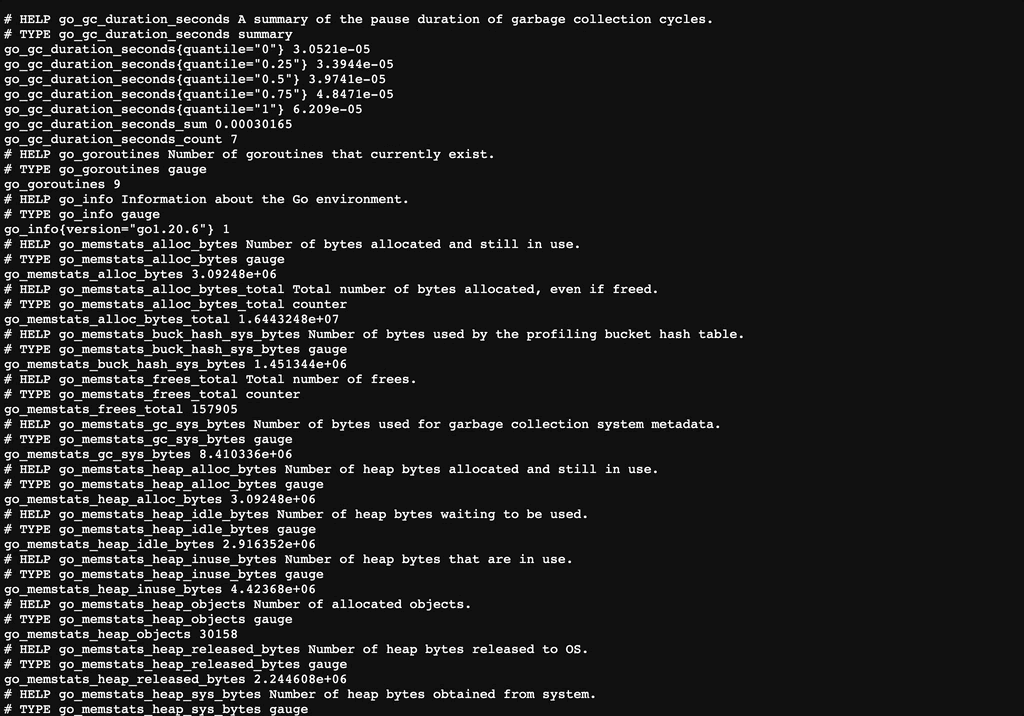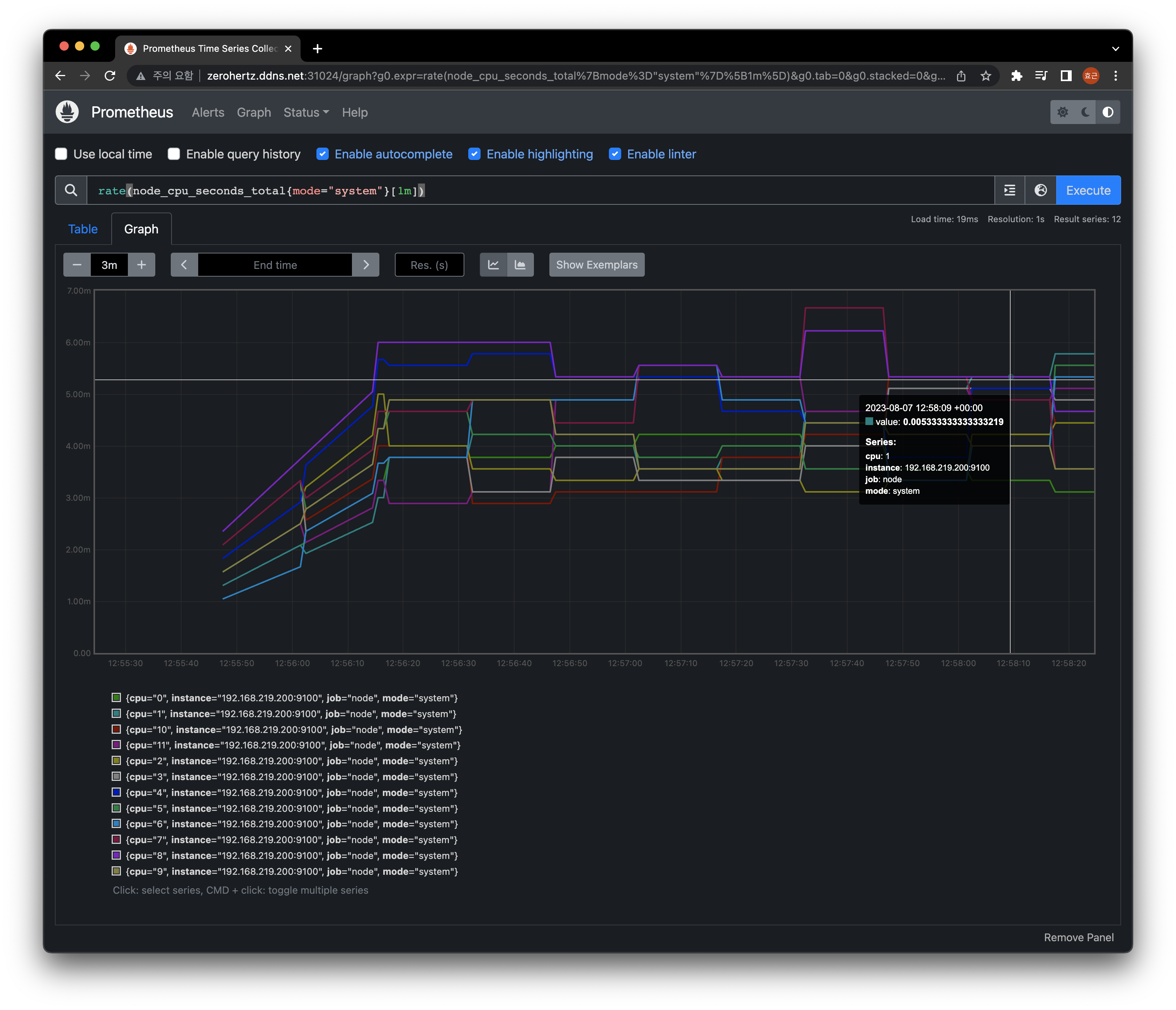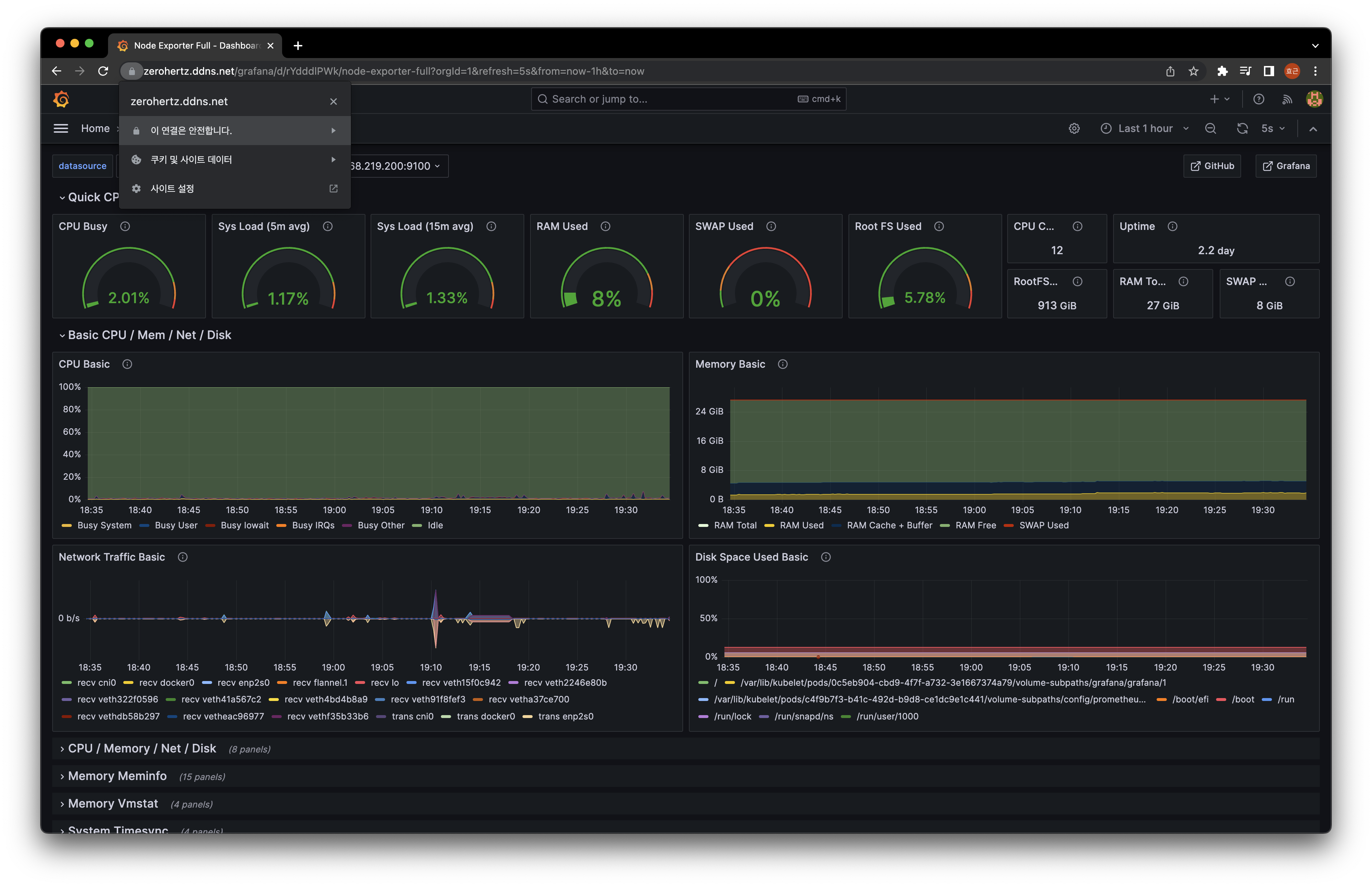Introduction
Node exporter의 system metric들을 Prometheus로 수집하고 Grafana로 시각화!

Node Exporter
1
2
3
| $ wget https://github.com/prometheus/node_exporter/releases/download/v1.6.1/node_exporter-1.6.1.linux-amd64.tar.gz
$ tar xvfz node_exporter-1.6.1.linux-amd64.tar.gz
$ sudo mv node_exporter-1.6.1.linux-amd64/node_exporter /usr/local/bin/node_exporter
|
/etc/systemd/system/node_exporter.service1
2
3
4
5
6
7
8
9
10
11
12
13
| [Unit]
Description=Node Exporter
Wants=network-online.target
After=network-online.target
[Service]
User=root
Group=root
Type=simple
ExecStart=/usr/local/bin/node_exporter
[Install]
WantedBy=multi-user.target
|
1
2
3
| $ sudo systemctl daemon-reload
$ sudo systemctl start node_exporter
$ sudo systemctl enable node_exporter
|
http://${CLUSTER_IP}:9100/metrics에서 아래와 같이 log들을 확인할 수 있다.

Prometheus
configmap/prometheus.yaml1
2
3
4
5
6
7
8
9
10
| global:
scrape_interval: 5s
evaluation_interval: 5s
scrape_configs:
- job_name: 'prometheus'
static_configs:
- targets: ['localhost:9090']
- job_name: 'node'
static_configs:
- targets: ['${CLUSTER_IP}:9101']
|
1
2
| $ kubectl create namespace monitoring
$ kubectl create configmap prometheus --from-file=prometheus.yml=configmap/prometheus.yaml -n monitoring
|
prometheus.yaml1
2
3
4
5
6
7
8
9
10
11
12
13
14
15
16
17
18
19
20
21
22
23
24
25
26
27
28
29
30
31
32
33
34
35
36
37
38
39
40
41
42
43
44
45
46
47
48
49
50
51
52
53
54
55
56
57
58
59
60
61
62
63
64
65
66
67
68
69
70
71
72
73
74
75
76
77
78
79
80
81
82
83
84
| apiVersion: storage.k8s.io/v1
kind: StorageClass
metadata:
name: prometheus-storage
provisioner: kubernetes.io/no-provisioner
volumeBindingMode: WaitForFirstConsumer
---
apiVersion: v1
kind: PersistentVolume
metadata:
name: prometheus-logs
labels:
type: prometheus-logs
spec:
storageClassName: prometheus-storage
capacity:
storage: 1Gi
accessModes:
- ReadWriteOnce
hostPath:
path: "${DIRECTORY}/logs"
persistentVolumeReclaimPolicy: Retain
---
apiVersion: v1
kind: PersistentVolumeClaim
metadata:
name: prometheus
namespace: monitoring
spec:
storageClassName: prometheus-storage
accessModes:
- ReadWriteOnce
resources:
requests:
storage: 1Gi
selector:
matchLabels:
type: prometheus-logs
---
apiVersion: apps/v1
kind: Deployment
metadata:
name: prometheus
namespace: monitoring
spec:
selector:
matchLabels:
app: prometheus
template:
metadata:
labels:
app: prometheus
spec:
containers:
- name: prometheus
image: prom/prometheus
ports:
- containerPort: 9090
volumeMounts:
- name: data
mountPath: /prometheus
- name: config
mountPath: /etc/prometheus/prometheus.yml
subPath: prometheus.yml
volumes:
- name: data
persistentVolumeClaim:
claimName: prometheus
- name: config
configMap:
name: prometheus
---
apiVersion: v1
kind: Service
metadata:
name: prometheus
namespace: monitoring
spec:
ports:
- port: 9090
selector:
app: prometheus
|
1
| $ kubectl apply -f prometheus.yaml
|


Grafana
grafana.yaml1
2
3
4
5
6
7
8
9
10
11
12
13
14
15
16
17
18
19
20
21
22
23
24
25
26
27
28
29
30
31
32
33
34
35
36
37
38
39
40
41
42
43
44
45
46
47
48
49
50
51
52
53
54
55
56
57
| apiVersion: v1
kind: PersistentVolumeClaim
metadata:
name: grafana
namespace: monitoring
spec:
accessModes:
- ReadWriteOnce
resources:
requests:
storage: 1Gi
---
apiVersion: apps/v1
kind: Deployment
metadata:
name: grafana
namespace: monitoring
spec:
selector:
matchLabels:
app: grafana
template:
metadata:
labels:
app: grafana
spec:
containers:
- image: grafana/grafana
name: grafana
env:
- name: GF_SECURITY_ADMIN_USER
value: ${ID}
- name: GF_SECURITY_ADMIN_PASSWORD
value: ${PASSWORD}
ports:
- containerPort: 3000
volumeMounts:
- name: data
mountPath: /var/lib/grafana
volumes:
- name: data
persistentVolumeClaim:
claimName: grafana
---
apiVersion: v1
kind: Service
metadata:
name: grafana
namespace: monitoring
spec:
type: NodePort
ports:
- port: ${Grafana_Port}
targetPort: 3000
nodePort: ${Grafana_Port}
selector:
app: grafana
|
1
| kubectl apply -f grafana.yaml
|
Node Exporter Full를 import하여 dashboard를 구성했다!


Ingress
Ingress 시도 및 실패,,, (traefik)
traefik-config.yaml1
2
3
4
5
6
7
8
9
10
11
12
13
14
15
16
| apiVersion: v1
kind: ConfigMap
metadata:
name: traefik-conf
namespace: kube-system
data:
traefik.toml: |
[entryPoints]
[entryPoints.web]
address = ":80"
[entryPoints.websecure]
address = ":443"
[entryPoints.grafana]
address = ":${Grafana_Port}"
[entryPoints.prometheus]
address = ":${Prometheus_Port}"
|
1
2
3
4
| $ kubectlapply -f traefik-deployment.yaml
configmap/traefik-conf created
$ kubectl edit deployment traefik -n kube-system
deployment.apps/traefik edited
|
traefik1
2
3
4
5
6
7
8
9
10
11
12
13
14
15
16
17
18
19
20
21
22
23
24
25
| ...
spec:
...
template:
...
spec:
containers:
...
volumeMounts:
- mountPath: /data
name: data
- mountPath: /tmp
name: tmp
- name: config
mountPath: /etc/traefik
readOnly: true
...
volumes:
- emptyDir: {}
name: data
- emptyDir: {}
name: tmp
- name: config
configMap:
name: traefik-conf
|
1
2
3
| $ kubectl rollout restart deployment/traefik -n kube-system
deployment.apps/traefik restarted
$ kubectl edit svc traefik -n kube-system
|
traefik1
2
3
4
5
6
7
8
9
10
11
12
13
14
15
| spec:
...
ports:
...
- name: grafana
nodePort: ${Grafana_Port}
port: ${Grafana_Port}
protocol: TCP
targetPort: ${Grafana_Port}
- name: prometheus
nodePort: ${Prometheus_Port}
port: ${Prometheus_Port}
protocol: TCP
targetPort: ${Prometheus_Port}
...
|
1
2
3
4
5
| kubectlget svc -n kube-system
NAME TYPE CLUSTER-IP EXTERNAL-IP PORT(S) AGE
kube-dns ClusterIP 10.43.0.10 <none> 53/UDP,53/TCP,9153/TCP 11m
metrics-server ClusterIP 10.43.195.230 <none> 443/TCP 11m
traefik LoadBalancer 10.43.66.36 ${IP} 80:32633/TCP,443:31858/TCP,${Grafana_Port}:${Grafana_Port}/TCP,${Prometheus_Port}:${Prometheus_Port}/TCP 11m
|
정신 못차리고 HTTPS를 도입해보려고 Ingress를 시도하려다 또 실패 ~
1
2
3
4
5
| $ openssl req -x509 -nodes -days 365 -newkey rsa:2048 -keyout tls.key -out tls.crt -subj "/CN=${HOST}"
$ kubectl create secret tls grafana-tls --key tls.key --cert tls.crt -n monitoring
$ kubectl get secret -n monitoring
NAME TYPE DATA AGE
grafana-tls kubernetes.io/tls 2 36s
|
grafana.yaml1
2
3
4
5
6
7
8
9
10
11
12
13
14
15
16
17
18
19
20
21
| apiVersion: networking.k8s.io/v1
kind: Ingress
metadata:
name: grafana-ingress
namespace: monitoring
spec:
rules:
- host: ${HOST}
http:
paths:
- path: /
pathType: Prefix
backend:
service:
name: grafana
port:
number: ${Grafana_Port}
tls:
- hosts:
- ${HOST}
secretName: grafana-tls
|
1
| $ kubectl apply -f grafana.yaml
|
traefik.yaml1
2
3
4
5
6
7
8
9
10
11
12
13
14
15
16
| apiVersion: traefik.containo.us/v1alpha1
kind: IngressRoute
metadata:
name: grafana-ingressroute
namespace: monitoring
spec:
entryPoints:
- websecure
routes:
- match: Host(`${HOST}`)
kind: Rule
services:
- name: grafana
port: ${Grafana_Port}
tls:
secretName: grafana-tls
|
1
2
| $ kubectl apply -f traefik.yaml
$ kubectl get ingressroute -n monitoring
|
삽질을 통해 결국 해냈다!
우선 이 글에서 확인할 수 있듯 Traefik으로 HTTPS protocol을 하는 법을 익혔고 거기에 path를 추가하여 성공했다!
Path를 설정하고 HTTPS로 monitoring service를 배포하는 방법은 아래와 같다.
우선 path를 Grafana service 내부에서도 인지해야하기 때문에 아래와 같은 설정 파일을 만들고 ConfigMap을 생성한다.
grafana.ini1
2
| [server]
root_url = https://${DDNS}/grafana
|
1
| $ kubectl create configmap grafana --from-file=grafana.ini=configmap/grafana.ini -n monitoring
|
위에서 선언한 ConfigMap을 Deployment에 알려주고, path를 Middleware와 IngressRoute에 설정하면 끝이다.
grafana.yaml1
2
3
4
5
6
7
8
9
10
11
12
13
14
15
16
17
18
19
20
21
22
23
24
25
26
27
28
29
30
31
32
33
34
35
36
37
38
39
40
41
42
43
44
45
46
47
48
49
50
51
52
53
54
55
| ...
---
apiVersion: apps/v1
kind: Deployment
metadata:
name: grafana
namespace: monitoring
spec:
...
template:
...
spec:
containers:
...
volumeMounts:
...
- name: grafana
mountPath: /etc/grafana/grafana.ini
subPath: grafana.ini
volumes:
...
- name: grafana
configMap:
name: grafana
---
...
---
apiVersion: traefik.containo.us/v1alpha1
kind: Middleware
metadata:
name: grafana
namespace: monitoring
spec:
stripPrefix:
prefixes:
- "/grafana"
---
apiVersion: traefik.containo.us/v1alpha1
kind: IngressRoute
metadata:
name: grafana
namespace: monitoring
spec:
entryPoints:
- websecure
routes:
- match: Host(`${DDNS}`) && PathPrefix(`/grafana`)
kind: Rule
middlewares:
- name: grafana
services:
- name: grafana
port: 80
tls:
certResolver: myresolver
|








